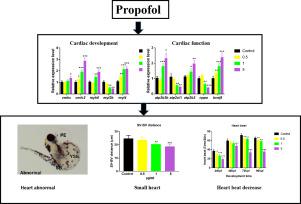Comparative Biochemistry and Physiology C: Toxicology & Pharmacology ( IF 3.9 ) Pub Date : 2020-06-23 , DOI: 10.1016/j.cbpc.2020.108838 Xiaopan Luo 1 , Long Chen 2 , Yunlong Zhang 2 , Jintao Liu 2 , Hong Xie 3

|
Propofol, a commonly used anesthetic, is convenient to use, induces quick effect, enables rapid recovery, and is widely accessible given its stable supply. However, its adverse effects are a concern. Reportedly, propofol exhibits a significant inhibitory effect on the respiratory and circulatory systems. Furthermore, intravenous administration of this drug results in hypotension, rapid heart rate, and respiratory failure. Because many pregnant women are administered propofol during childbirth, it may have a significant negative effect on the development of infants. Propofol can cause considerable developmental neurotoxicity and has known activity on the heart. However, the underling mechanisms of these toxicities remain unclear. In the present study, zebrafish embryos were exposed to propofol at different concentrations (0.05, 0.1, 0.5, 1, 5, 10, and 20 μg/ml) to determine its developmental and cardiac toxicities. Propofol exposure decreased the survival rate and hatchability of zebrafish embryos. Additionally, the embryo malformation rate increased in a concentration-dependent manner. Different types of malformations were observed following propofol administration. The proportion of pericardial cysts increased, whereas the heart rate and size decreased with an increase in propofol concentration. The quantitative reverse-transcription polymerase chain reaction revealed that propofol significantly altered the expression of genes related to cardiac development and functions in zebrafish. Collectively, our findings indicate that propofol exposure induces significant developmental and cardiac toxicities in zebrafish.
中文翻译:

异丙酚在斑马鱼幼虫中的发育和心脏毒性。
丙泊酚是一种常用的麻醉剂,使用方便,起效快,恢复迅速,并且由于其稳定的供应而可广泛获得。但是,它的不利影响是一个问题。据报道,异丙酚对呼吸系统和循环系统表现出显着的抑制作用。此外,静脉内给药该药物会导致低血压,心律加快和呼吸衰竭。由于许多孕妇在分娩时服用丙泊酚,因此可能对婴儿的发育产生重大负面影响。异丙酚可引起相当大的发育神经毒性,并且对心脏具有已知的活性。但是,这些毒性的潜在机制仍不清楚。在本研究中,斑马鱼胚胎以不同浓度(0.05、0.1、0.5、1、5、10,和20μg/ ml)以确定其发育和心脏毒性。异丙酚的暴露降低了斑马鱼胚胎的存活率和孵化率。另外,胚胎畸形率以浓度依赖性方式增加。异丙酚给药后观察到不同类型的畸形。心包囊肿的比例增加,而心率和大小随丙泊酚浓度的增加而降低。定量逆转录聚合酶链反应显示,丙泊酚显着改变了与斑马鱼心脏发育和功能相关的基因的表达。总的来说,我们的发现表明,异丙酚的暴露在斑马鱼中引起明显的发育和心脏毒性。异丙酚的暴露降低了斑马鱼胚胎的存活率和孵化率。另外,胚胎畸形率以浓度依赖性方式增加。异丙酚给药后观察到不同类型的畸形。心包囊肿的比例增加,而心率和大小随丙泊酚浓度的增加而降低。定量逆转录聚合酶链反应显示,丙泊酚显着改变了与斑马鱼心脏发育和功能相关的基因的表达。总的来说,我们的发现表明,异丙酚的暴露在斑马鱼中引起明显的发育和心脏毒性。异丙酚的暴露降低了斑马鱼胚胎的存活率和孵化率。另外,胚胎畸形率以浓度依赖性方式增加。异丙酚给药后观察到不同类型的畸形。心包囊肿的比例增加,而心率和大小随丙泊酚浓度的增加而降低。定量逆转录聚合酶链反应显示,丙泊酚显着改变了与斑马鱼心脏发育和功能相关的基因的表达。总的来说,我们的发现表明,异丙酚的暴露在斑马鱼中引起明显的发育和心脏毒性。胚胎畸形率以浓度依赖的方式增加。异丙酚给药后观察到不同类型的畸形。心包囊肿的比例增加,而心率和大小随丙泊酚浓度的增加而降低。定量逆转录聚合酶链反应显示,丙泊酚显着改变了与斑马鱼心脏发育和功能相关的基因的表达。总的来说,我们的发现表明,异丙酚的暴露在斑马鱼中引起明显的发育和心脏毒性。胚胎畸形率以浓度依赖的方式增加。异丙酚给药后观察到不同类型的畸形。心包囊肿的比例增加,而心率和大小随丙泊酚浓度的增加而降低。定量逆转录聚合酶链反应显示,丙泊酚显着改变了与斑马鱼心脏发育和功能相关的基因的表达。总的来说,我们的发现表明,异丙酚的暴露在斑马鱼中引起明显的发育和心脏毒性。定量逆转录聚合酶链反应显示,丙泊酚显着改变了与斑马鱼心脏发育和功能相关的基因的表达。总的来说,我们的发现表明,异丙酚的暴露在斑马鱼中引起明显的发育和心脏毒性。定量逆转录聚合酶链反应显示,丙泊酚显着改变了与斑马鱼心脏发育和功能相关的基因的表达。总的来说,我们的发现表明,异丙酚的暴露在斑马鱼中引起明显的发育和心脏毒性。


























 京公网安备 11010802027423号
京公网安备 11010802027423号